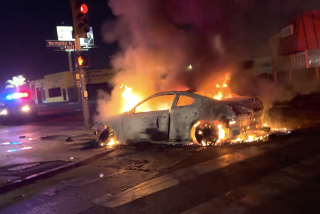Neighbors of Slain Girl, Man Despair at Violence
A pair of makeshift memorials appeared on a stretch of sidewalk Monday, symbols of two lives taken and the misery blanketing an Eastside neighborhood desperate to reclaim itself.
The memorials--clusters of flowers, candles and statues of the Virgin Mary--mark a drive-by shooting Sunday that killed two young people--one, a 10-year-old girl.
“You see flowers and you want to be happy,” said Iris Torres, 17, wiping back tears. “On this street, right now, it makes you just sad.”
At one end of the 100 block of South Clarence Street, red roses surround a white T-shirt once worn by Raymond Hernandez--dead at 19. He was described as a boy who had gotten into trouble but was trying to do better for himself.
Hernandez was shot in a drive-by attack while washing a car at a friend’s house. Bullets ricocheted down the street. One of them fatally injured Stephanie Raygoza, 10.
In front of the roses, three of Stephanie’s friends Monday recalled the chaos.
The children had been playing in front of Stephanie’s house just before sundown, pushing their scooters and skateboards up and down the sidewalk in the middle of their three-day weekend.
In a blur of motion, said the children, a green van sped down the street. Then came another car. They heard the crackle of gunfire.
“It was a cross-fire,” said an 8-year-old boy who was in Stephanie’s house at the time and heard the gunfire. “There was shooting coming from all over.”
Stephanie, a fifth-grader at nearby Utah Elementary, was hit in the chest, the children said. The little girl’s parents--who were mourning inside their home Monday--rushed the little girl to nearby White Memorial Hospital, said Los Angeles Police Department spokeswoman Charlotte Broughton. Stephanie was pronounced dead Sunday at 6:25 p.m.
Broughton said an arrest was made Monday in the case, but police would not give a name.
“Stephanie was looking forward to today,” said a relative, Rigoberto Hernandez, 28, as he stood by a wrought iron fence close to where Stephanie fell. “She knew that today was a holiday. And so she had just been asking her mother if she could go today to buy a new dress. One with lots of color.”
Hernandez said that because of the dangers of living in a neighborhood where at least four rival gangs often violently cross paths, Stephanie’s parents demanded she play only in front of the family home. On the small patch of grass and sidewalk where she was allowed to roam, he said, Stephanie enjoyed playing make-believe.
Stephanie’s playmates clutched a small color picture of their friend. In it, she stands in a playground next to one of her teachers, smiling. “She was always a teacher in her games,” said Hernandez. “That’s what she pretended to be.”
Just down the street, in front of a worn bungalow, friends of Raymond Hernandez clutched one another near where he died, crying at times and playing George Clinton hip-hop tunes at high volume.
Although the group mostly kept to themselves, some sauntered down the block to stop by Stephanie’s memorial, about 20 yards away. One young man, who said he did not know Stephanie, crouched down and said a long, silent prayer.
Raymond Hernandez “just wanted to get his life straight,” said Iris Torres, as she stood nearby wiping her eyes.
“This is just craziness,” said one of the young men, a self-described former gangbanger who asked that his name not be used. “This was some rival enemy gang. They got my homie. Not only him, but an innocent girl. Things have got to change down here.”
This Boyle Heights neighborhood east of downtown Los Angeles consists mostly of small homes and a few grocery and liquor stores. The Pico Aliso and Aliso Village housing projects are less than a block away. The city is replacing many of the aging apartments, leaving behind piles of rubble during the massive renovation.
Residents said the construction, along with gang violence, has put the neighborhood at a crossroads. Some have decided to fight violence in new ways. Every other Friday evening, dozens of residents walk together through the streets, asserting their claim on the neighborhood.
“We call them peace walks,” said Maria Molina, 16, in front of her tidy apartment in Las Casitas, the name of the new public housing. “That’s what we are trying for, that’s what we are praying will come to this place. Just plain peace.”
More to Read
Sign up for Essential California
The most important California stories and recommendations in your inbox every morning.
You may occasionally receive promotional content from the Los Angeles Times.











